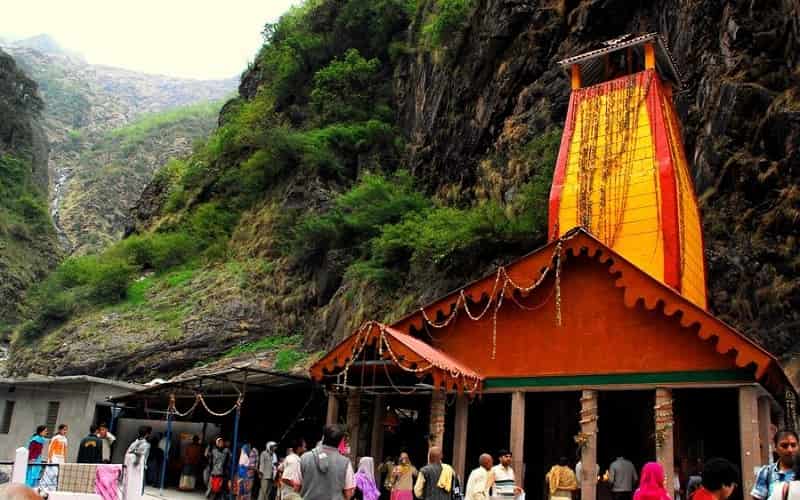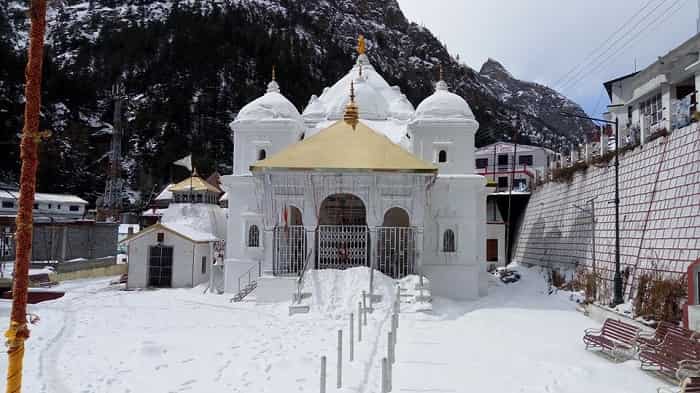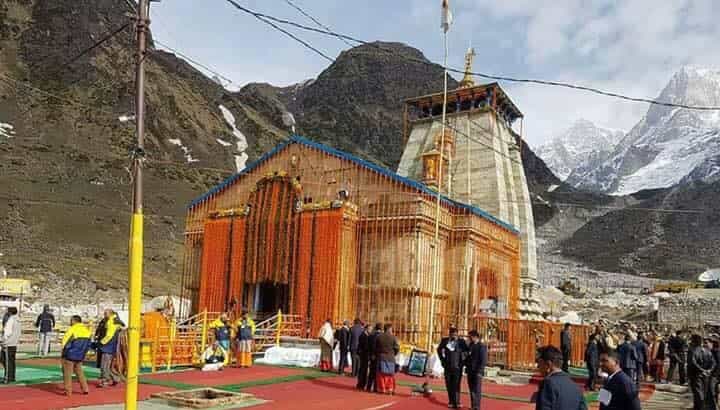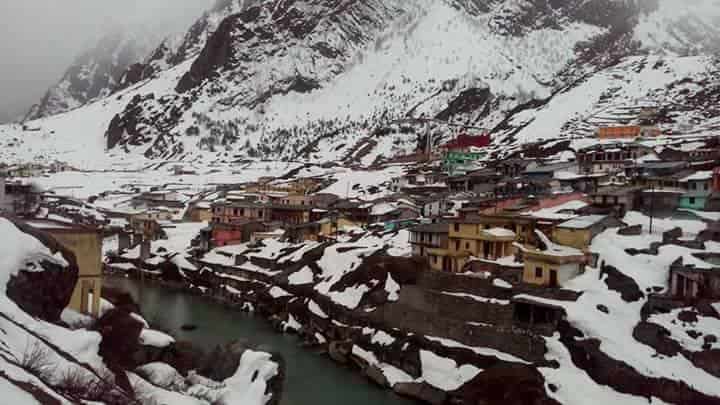Char Dham Yatra is famous for being one of the most difficult and challenging pilgrimages in the world. To make this spiritual Endeavour easier we have come up with a comprehensive set of guides to complete it. We have managed to create a wholesome guidebook answering all the common doubts, new routes, and tips related to Chardham Yatra. Reading this will help you in preparing yourself practically, mentally, and physically to deal with the challenges that come along the way.
As the snow melts away from the Himalayan valley giving way to clear, open blue skies, the Garhwal region of Devbhoomi Uttarakhand springs to life with pure divinity and enthusiasm of the Chardham Yatra pilgrims. These pilgrims make their way from all over India to complete the ancient pilgrimage of Chardham. This visit to the temples of Kedarnath, Badrinath, Gangotri, and Yamunotri is a customary tradition that is followed by devout Hindus.
Significance of Chardham Yatra
Pilgrimages are the crux of any religion. In the same way, Char Dham Yatra forms the core of the Hindu religion. Going on this arduous journey to Kedarnath, Badrinath, Gangotri, and Yamunotri is an eye-opening experience for many. It is considered to be a potentially life-changing trip as well. The yatra in itself is considered to be a path to salvation. According to ancient scriptures and holy books, taking up the Char Dham Yatra will open up the door to complete salvation. Taking up this journey will free the devotees from the karmic cycle of birth and rebirth. Chardham Yatra will ensure that the pilgrims achieve a new perspective in life and go back as a changed individuals. People take up this journey to attain a higher level of being and peace of mind. The Vedas have given credit to the Char Dham Yatra as a means of rejuvenating oneself.
About Char Dham Temples
Legend of Yamunotri Temple

Dedicated to the goddess Yamuna, the 18th-century temple of Yamunotri marks the starting point of the holy Yamuna River. According to Hindu scriptures, Yamunotri is Yamraj or the god of death’s sister. Yamraj has once promised his sister, during the holy event of Bhai Dooj, that whoever will take a holy dip in the Yamuna River, they will not be taken to ‘Yamlok’ or the palace where dead souls are taken. This shows that a dip in the Yamunotri River will free the devotee from untimely death. Not just that, doing so will also free the devotees from a painful life while also helping them achieves salvation or moksha. Another instance tells us that Yamunotri Temple is built exactly on the place where Asit Muni used to stay and take daily dips in Ganga as well as Yamunotri.
Legend of Gangotri Temple

The history of Gangotri is associated with king Bhagirath’s penance. According to legends, King Bhagirath had made his way to Brahma Kapal behind Gangotri temple to meditate on the goddess Ganga. He did this with the advice of his priests. The scriptures tell us that king Bhagirath’s kingdom was in shambles. The priests said that it was due to the unsettled souls of his ancestors. Their souls could only be settled once their ashes are blessed in Ganga water. However, Ganga didn’t flow on earth then. The only way of inviting her to bless the earthly realm and grant salvation to the departed souls was by meditating hard and pleasing her. King Bhagirath did that and with the help of Brahma and Lord Shiva, Ganga finally made her way to the earth to grant moksha to all the departed souls.
Legend of Kedarnath Temple

Located on the bank of Mandakini River stands one of the 12 Jyotirlinga of India, Kedarnath. This ancient temple houses the very unique triangular shipped lingam. Set against the backdrop of the Kedar dome of mountain ranges, the first foundation for the temple was established by the Pandavas. According to ancient holy books, it is also the place which was once resided by Lord Shiva, Goddess Parvati as well as Lord Vishnu. The current temple structure was first constructed by the great sage and propagator of Advaita Vedanta, Adi Shankaracharya. This shows that the temple is located in a very holy location that holds a lot of spiritual and religious importance. The temple is so old that it has also been subjected to a mini ice age situation for 400 years.
Legend of Badrinath Temple

There are many legends and folktales associated with Badrinath. Located next to the holy Alaknanda River Badrinath Dham is set against the scenic backdrop of the Nar and Narayan mountain range. The legend of Badrinath goes back to the time when gods used to walk on earth i.e. during the Satyug. According to scriptures when Lord Vishnu was in deep meditation under the Badri tree when suddenly the weather changed. The region became encapsulated in a cold stormy situation but the Lord continued to meditate without flinching. To protect his consort goddess Laxmi went and turned herself into a Badri tree in order to shield him from the horrible weather conditions. Another interesting story involves the twin sages Nar and Narayan. They had chosen Badrinath Dham as their spot for performing their intense meditation to please Lord Vishnu. Impressed by the twin’s endurance and hard work, the lord made his appearance in front of them.
Chardham Yatra Registration 2024
Devotees going for Chardham Yatra 2024 must get themselves registered. This is one of the most important and compulsory formalities that every devotee is expected to complete. All you need is to register on the official Chardham Yatra website with the help of a valid E-mail ID along with photo and address proof. Upon completion, the registered person will be given an E-pass that will grant permission for Darshan to all the holy shrines. The registration is done on the Uttarakhand Chardham Devasthanam management board website.
If not online, the devotees can also get themselves registered on the spot. Some of the places for this purpose are the Rishikesh bus stand, Rishikesh Gurudwara, Haridwar Railway Station, Hina Uttarkashi, Dupatta Uttarkashi, Govindghat, and Pandukeshwar.
How to reach Char Dham
The Chardham temples are located in the upper reaches of the Himalayas. Due to the rugged and sensitive terrain, Chardham temples are unreachable directly through railway or flight. Most of the Dhams are directly connected through roadways while in some cases people have to trek their way up to the temples.
Through the constant efforts shown by the government of Uttarakhand, the temples are made accessible through cars, buses, and shared jeep services. Here is how you can reach Chardham.
Chardham Yatra by Road
By road, the journey to Chardham starts from Haridwar and Rishikesh which has also earned them the name of the ‘gateway to Chardham’. There are also routes available from Dehradun. People traveling from Delhi, Punjab, Haryana, and other nearby towns make their way through Haridwar and sometimes even choose to spend overnight in Rishikesh.
Chardham Yatra by Rail
The closest railhead to Chardham temples is located in Haridwar. It is connected to some nearby and faraway cities in India.
Chardham Yatra by Air
If traveling by flight then the nearest airport is located in Dehradun which is the jolly grant airport. The airport receives domestic commercial flights from almost all the major cities in India. After landing, there are buses and car rental services available connecting the airport to the Chardham temples?
The Sahastradhara Helipad in Dehradun offers helicopter services to Chardham temples. People, especially senior citizens, physically challenged individuals, or just devotees looking to travel with ease, choose to book a helicopter tour for Chardham.
Chardham Yatra by Helicopter
The overall cost of the Chardham yatra by helicopter will sum up to upwards of 1.5 Lakh per person. This will be inclusive of VIP Darshan Pass, pick up and drop off service in a private car, and accommodation service. The cost of a Kedarnath helicopter trip depends on the starting point and can cost anywhere between 4K to 10K per person.
Yamunotri Yatra by Helicopter – The helicopter trip to Yamunotri starts from the Sahastradhara Helipad and goes up to the Kharsali helipad near Yamunotri. The devotees then deboard the chopper and take a pony service to complete the 8 kms of an arduous trek up to the temple.
Gangotri Yatra by Helicopter – The devotees will be transferred from the Sahastradhara Helipad to the Gangotri Helipad in Harsil. The passengers will be taken to the main temple of Gangotri in a rented cab, taxi, or bus that will cover 24 km by road and it takes around an hour to reach, depending on the traffic.
Kedarnath Yatra By Helicopter – Located at an astonishing elevation a helicopter trip to Kedarnath is probably the most luxurious, safest, and quickest way to reach Kedarnath. The trip will begin from the Sahastradhara Helipad to one of the many different helipads in Kedarnath. There are many different helipads in Kedarnath where the helicopter from Sahastradhara lands which are Guptkashi, Sitapur, Sersi, Phata, etc. from here the passengers are then transferred to another chopper headed for the helipad close to Kedarnath temple. It is just 500 meters from the temple.
Badrinath Yatra by Helicopter – The nearest helipad to Badrinath is named after Badrinath itself. From Sahastradhara the helicopter will transfer the passengers to the Badrinath helipad. This is located just a km away from the main temple. Some people either walk up to the main entrance while there are also taxi/cab services available connecting the temple to the Badrinath Helipad.
Chardham Yatra Route
The Chardham Yatra begins from Haridwar for people traveling by road and from Dehradun for people traveling by helicopter. Traditionally the yatra is supposed to take place in a clockwise direction. This means that traditionally the yatra takes place from west to east. So keeping this in mind, the pilgrimage starts off at Yamunotri temple. This is followed by a visit to Gangotri Dham, then Kedarnath, and then finally Badrinath.
When it comes to the route map of Chardham, it depends on the mode of transportation the pilgrims choose to complete the yatra. Out of all the Dhams, Kedarnath and Yamunotri require treks of 8 and 18 kms respectively to complete the pilgrimage. There are alternate modes of transportation also available like Palki, Doli, or Pithu services to transfer people from the final road heads to the main temple entrance.
Chardham Yatra Route from Delhi via Haridwar by Bus / Car
- Delhi → Haridwar – 210 km (6 hours)
- Haridwar → Barkot – 220 km (7 hours)
- Barkot → Yamunotri – 36 km (drive) + 7 kms by trek
- Barkot → Uttarkashi – 100 km (4 hours)
- Uttarkashi → Gangotri – 100 km (4 hours)
- Uttarkashi → Rudraprayag – 180 km (7-8 hours)
- Rudraprayag → Kedarnath – 74 kms (drive) + 20 kms trek (new route)
- Rudraprayag → Badrinath – 160 km (6-7 hours)
Here Is the Char Dham Yatra Route by Helicopter
Dehradun – Yamunotri – Gangotri – Kedarnath – Badrinath
Best Time to visit Char Dhams
Each year Chardham Yatra begins in April / May and ends in October / November. The best time to go for Char Dham Yatra is from late April to early June, just before the beginning of monsoon season on the hills.
The arrival of the monsoon season triggers massive unexpected landslides and flooding situations that make the pilgrimage unsafe for the pilgrims. During this time the helicopter package for Chardham stands a chance to be canceled. However, the Chardham yatra remains open for pilgrims during this time of the year as well. If you plan your holiday accordingly then you can even travel during these months.
The other safe window that is favorable for the pilgrimage to continue is during the winter months of October to November or until the closing time of the temple doors. This is also a good time for the pilgrims to travel during the monsoon season for people who can stand the biting and chilly cold winter season of the Himalayan Hills.
Packing and Preparation Tips for Char Dham Yatra
-
- All the Chardham temples of Devbhoomi i.e. Kedarnath, Badrinath, Gangotri, and Yamunotri are all located at an elevation of over 3,000 meters above sea level. Make sure to pack a good amount of winter and warm, winter clothing like jackets, sweaters, thermal inners, socks, and mufflers. Even though daytime may seem pleasant and comfortable, it gets very cold as soon as the sunsets. Also, the weather conditions in the upper reaches of the Garhwal Himalayas are highly unpredictable so every pilgrim should be prepared to deal with this situation.
- The best way to deal with the cold and biting wind is by carrying a windcheater that will help the pilgrims stay warm and cozy.
- The weather in the entirety of the Chardham Yatra route is very unpredictable meaning that it can rain anytime. It is strongly advised for the pilgrims to carry raincoats and umbrellas along during the pilgrimage.
- For extra care, the pilgrims should also be carrying water-resistant shoes and an extra pair of socks for the yatra.
- Some other essentials the pilgrims should carry include sunglasses, sunscreen, and caps/hats. The pilgrims need complete protection from the scorching sun rays, especially in these high-altitude regions.
- To be extra prepared even during the summer season, people should remember to carry monkey caps and mufflers in order to keep themselves shielded from the cold winds that constantly blow on the hills.
- People should be well prepared to deal with the challenges that come with high-altitude terrain. Being located at an elevation of over 3,000 meters above sea level the pilgrims need to be in physically good condition. Yatris need to prepare well for the treks prior to the beginning of the pilgrimage and this can be done just by indulging in a simple workout regime of 20 minutes every day. Jogging, running, and walking should also be included in your prep for the pilgrimage. Physical fitness is needed to complete the Chardham journey mainly because the temples are located in very challenging locations. This is advisable for pilgrims traveling by road as well as by helicopter.
- Carry a medicine box containing all the relevant medication for the trip like pain killers, anti-Diarrhoea, and anti-fever medication.
- The Chardham Yatra can be incredibly mentally and physically draining no matter how much you are prepared. So make sure to carry chocolate, energy bars, nuts, and other dry fruits to re energies yourself.
- Make sure to carry a water bottle with a water filter because there may not be any water source available for long distances between the Dhams.
- Pregnant women, infants, and senior citizens over 65-70 years are advised to avoid taking the Chardham Yatra.
- Avoid wearing Sarees during the yatra as it may prove to be very constricting and uncomfortable to walk. You can wear Salwar Kameez or track pants along with a comfortable pair of shoes to make the journey comfortable.
- In your essentials bag make sure to carry flashlights, torches with an extra pair of batteries, and a power bank since the availability of electricity is questionable in these parts of the hills.
- Every Yatri is expected to get themselves registered. This is done for the safety of the pilgrims as well as to keep count. This is a mandatory procedure that can be done online and also on the spot in some places like Rishikesh.
- As a precautionary measure, Yatris are expected to carry a copy of the vaccination report and a negative COVID – 19 RTPCR test which is just 2-3 days old.
FAQs for Planning a Trip to Char Dham
Q: How Can I Do Char Dham Yatra?
Ans. There are 2 primary modes of completing the Chardham Yatra, roadway or airway. Pilgrims can choose from any of these 2 services to complete their spiritual sojourn. If you are going to choose the helicopter package for Chardham then make sure to book from a government-approved company.
Q: Should I Choose A Tour Operator For Char Dham Yatra 2024?
Ans. Although it is possible to plan your own trip, it can lead to very exhausting and underwhelming results. Booking from a government-approved Chardham Tour Provider Company will ensure that the pilgrims are treated with the best available facilities like smooth transfers, tension-free Darshan experience, and comfortable stays. Other than that many companies also offer Yatri registration services along with other travel-related services. All this and the 24*7 availability of a travel consultant throughout the pilgrimage makes the yatra fulfilling.
Q: Which Dham Should I Visit First?
Ans. Traditionally the first Dham that every pilgrim should visit is Yamunotri Dham. The yatra goes from west to east and Yamunotri comes first in this manner. This is followed by a visit to Gangotri, then Kedarnath, and finally Badrinath.
Q: What Is The Cost Of Char Dham Yatra?
Ans. There are many different aspects that impact the cost of a pilgrimage as huge and comprehensive as Chardham. It depends on whether you are planning and making bookings on your own or if you are looking for a Chardham Tour company. If planning on your own by road, then it may cost anywhere from 30,000/- rupees to 50,000/- rupees. This is the cost of the trip after the pilgrim’s arrival in Haridwar. If choosing a helicopter service for Chardham then it may cost upwards of 1 lakh rupees.
Q: What Is The Cost Of VIP Darshan In Kedarnath?
Ans. A VIP Darshan in Kedarnath costs 2,100/- rupees.
Q: What Is The Cost Of Helicopter Service From Guptkashi To Kedarnath Helipad?
Ans. The helicopter ticket price of a round trip from Phata to Kedarnath and back sums up to 5,000/- rupees. This rate is only valid for Phata to Kedarnath in 2024 only.
Q: How to Reach Badrinath from Kedarnath by Road?
Ans. The distance between Badrinath and Kedarnath is 218 km. The road route is as follows: Kedarnath – Ukhimath – Chopta – Gopeshwar – Chamoli – Pipalkoti – Joshimath – Govindghat – Badrinath. The road will go via Joshimath and pilgrims also have the choice of reaching Badrinath by helicopter directly.
